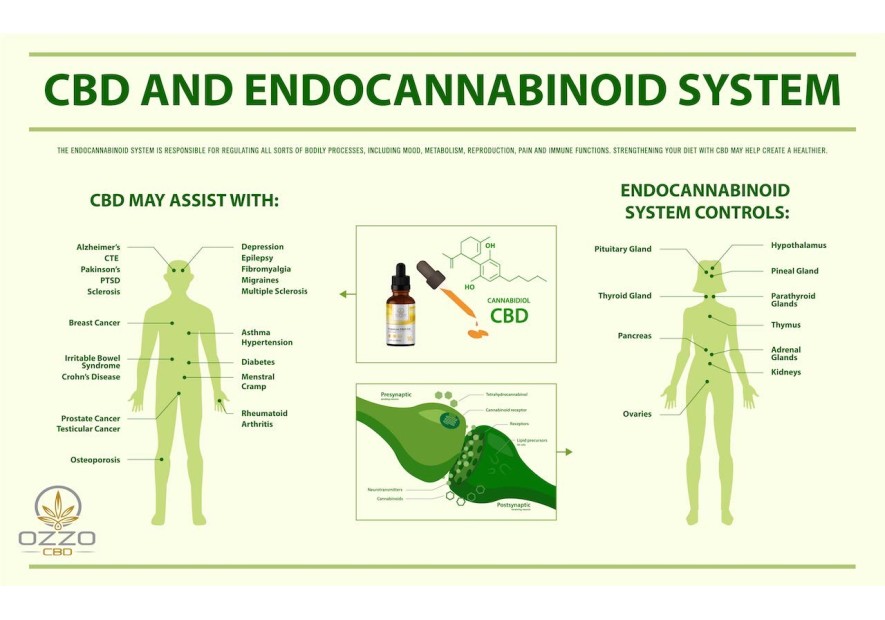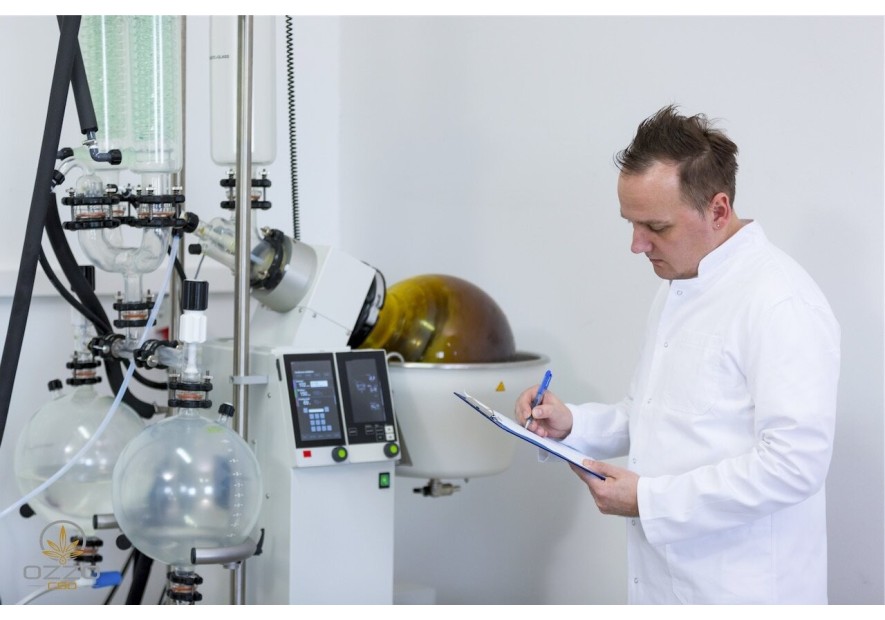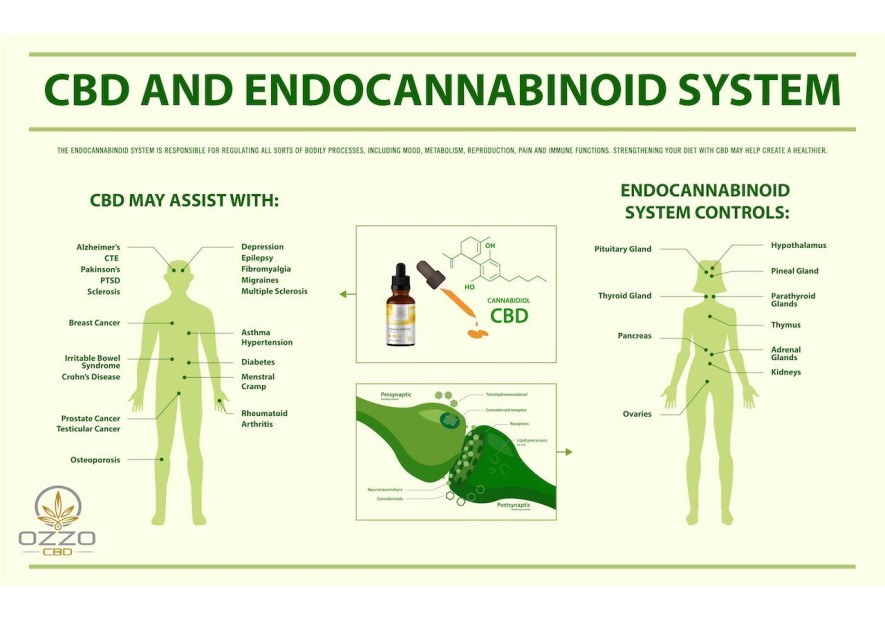What is the endocannabinoid system?

The endocannabinoid system - or ECS in short - is responsible for regulating balance in our body’s immune response, communication between cells, metabolism, memory, sleep, appetite, digestion, hunger, mood, motor control, immune function, reproduction and fertility, pleasure and reward, pain, and temperature regulation. In spite of the integral role this system takes on, until the mid-1990s it remained an unknown part of the human body’s functions. The system is named after the plant that inspired its discovery. The endocannabinoid system is important to your overall health and equilibrium, but its importance is only recently becoming fully understood by the medical community. It is through this system that the naturally occurring cannabinoids from CBD oil interact with our bodies and trigger its many beneficial effects. Because of how it affects the way our bodies work, a healthy endocannabinoid system is critical and it’s essential that we learn how to maintain it. The endocannabinoid system is made up of several integrated mechanisms:
- Enzymes responsible for creating and destroying cannabinoids.
- Receptor sites on cells to receive cannabinoids.
- Endocannabinoids themselves (cannabinoid-like compounds that are naturally produced in the human body).
- These mechanisms are predominantly responsible for communication within the body to best regulate various biological responses.
One of the prime questions raised in these early studies was whether or not the body produces its own natural equivalents to the previously discovered compounds called phytocannabinoids, like THC and CBD, found in the cannabis plant. The answer turned out to be positive – in the form of the endocannabinoids anandamide and 2-AG, which are like the two prominent analogs to THC and CBD. With the understanding that we humans create our own cannabinoids, the door to deconstructing their purpose was opened.
Endocannabinoids as a response
Endocannabinoids are created in response to needs within the larger physiological system and are used for the body’s regulatory functions. They act on presynaptic cells to control the volume at which communicating signals are sent. This is how endocannabinoids affect the duration and intensity of the wide range of physiological processes under their control. While the endocannabinoid system is linked to a number of important processes and is concentrated in the brain, nervous system, and reproductive organs, it does not affect regions of the brain controlling heart and lung function. This characteristic is one of the main reasons that fatal overdoses of cannabinoids do not occur.
How does the endocannabinoid system work?
Whenever there are deviations from homeostasis in the body’s functions, the endocannabinoid system is activated and begins to respond accordingly by synthesizing endocannabinoids, which act as neurotransmitters. When the body creates neurotransmitters for the endocannabinoid system, they are picked up by specialized cannabinoid receptors, which sit on the surface of cells. These receptors are found in a wide range of physiological regions, such as in:
- The immune system
- Organs and glands
- Connective tissue
- The brain (most significantly)
Like a key that fits into a lock, endocannabinoids interact with these receptors and transmit information about changing conditions to kick start a response, with the goal of helping the body achieve homeostasis, or equilibrium, despite outside influences. The endocannabinoid system’s receptor sites include CB1 and CB2 receptor variants, which respond differently to various cannabinoids. CB1 receptors are most prevalent in the central nervous system and are linked to the following benefits:
- Modulation of stress and anxiety
- Increased appetite
- Decreased nausea
- Balance of immune system
- Inhibition of tumors
CB2 receptors are found mostly on cells in the immune system and seem to dominate in fighting inflammation and damage to tissue. Some cells can even contain both types of receptors, each responsible for a different function. There are two major endocannabinoids – 2-Arachidonoylglycerol (2-AG) and Anandamide (AEA). 2-AG is considered a full agonist of both CB1 and CB2 receptors. This means that it binds with and fits well inside both receptors to activate them to stimulate a physiological response. Anandamide is considered a partial agonist of both receptors, because, while it binds with and activates the receptors, it doesn’t fit as well inside them and subsequently doesn’t trigger such a powerful physiological response (Parcher, Batkai, & Kunos, 2006). Once the function that had deviated from homeostasis returns to equilibrium and the endocannabinoids are no longer needed, the third piece of the system – the metabolic enzymes – breaks down and degrades them. Fatty acid amide hydrolase (FAAH) degrades Anandamide, and monoacylglycerol lipase (MAGL) breaks down 2-AG. By eliminating the endocannabinoids, the endocannabinoid system “turns off” the molecular signals and ends whatever physiological activity it had stimulated.
How does the endocannabinoid system affect your health?
Since discovering the endocannabinoid system and its parts, researchers have worked to further understand how the endocannabinoid system may be used therapeutically to:
- Decrease pain
- Fight cancer
- Help neurodegenerative diseases
- Promote general health
Overall, research indicates that the endocannabinoid system helps ensure that the body’s immune and central nervous systems are running correctly. Finding ways to modulate the endocannabinoid system’s activity opens pathways to an amazingly disparate set of chronic diseases and disorders (Pacher and Kunos, 2013). For example, evidence indicates that stimulation of cannabinoid receptors may aid in the deletion of old traumatic memories and provide clinical benefits in age-related diseases associated with brain inflammation (Ruehle et al, 2012) (Marchalant, et al., 2008). This list also includes difficult conditions like Parkinson’s, multiple sclerosis, and cancer.
Memory
There is also evidence that the endocannabinoid system may aid in the deletion of old memories (Ruehle et al, 2012). The extinction of aversive memories is important to the progress of PTSD patients and in behavior conditioning for those with chronic anxiety. By allowing patients to forget painful memories, they can reset their stress and anxiety responses to certain experiences and create a more positive reaction.
Appetite and weight
Cannabis has a well-known ability to increase appetite. However, because endocannabinoids are used internally for appetite control, inverse agonists to the CB1 receptor can be used to combat obesity by shutting off the body’s desire for food (Pagotto et al, 2005). The opposite can be accomplished by stimulating appetite in those suffering from wasting syndrome and allowing them to gain weight (Kogan and Mechoulam, 2007). Finally, endocannabinoids also regulate metabolism and help control the transfer of energy through cells, ensuring optimal use of the food we do take in.
Anxiety
In today’s world, it is a common reality that the natural cycle of anxiety and physical response cannot be shut off due to constant exposure to stressors. Because cannabinoids affect the body’s glandular response to continued stress to regulate and temper response, the endocannabinoid system has implications for the way in which modern humans process long-term stress and other enduring anxiety triggers (Akirav).
Immune function and inflammation
Additionally, endocannabinoids promote proper immune function to allow for greater overall wellness. The role they play in immune homeostasis supports “spontaneous activation of immune cell function,” helping with inflammation and possibly even resulting neurological diseases (Pandey et al, 2009).
How do cannabinoids from CBD oil work with the endocannabinoid system?
As scientists learn more about the endocannabinoid system, they also explore the potential role the cannabis-derived cannabinoids like THC, cannabidiol (CBD), cannabinol (CBN), and more could play in supporting the system. Cannabinoids mimic the behavior of endocannabinoids and interact with the cannabinoid receptors to augment the endocannabinoid system. As the cannabinoids interact with the cannabinoid receptors, they stimulate various physiological responses. THC, the well-recognized psychoactive compound found in medical marijuana, activates receptors to elicit a chemical response. It is considered an agonist of both CB1 and CB2 receptors because it directly binds to the receptors and activates them. THC tends to favor CB1 receptors because it fits very well inside them and therefore is able to stimulate a strong physiological reaction. When THC reacts with CB1 receptors, this is what causes the well-known “high” feeling from marijuana. THC also directly activates CB2 receptors, but is considered a partial agonist and therefore doesn’t elicit such a strong physiological response. CBD causes chemical changes by blocking receptors. It tends to have low affinity for both CB1 and CB2 receptors, and instead acts as an indirect antagonist of agonists. This means that CBD sits imperfectly inside the receptors, not activating them but supporting other chemical messengers like THC from binding to them. As we continue to learn more about the endocannabinoid system, we will also learn about the potential for active compounds from cannabis (like THC, CBD, and CBN) to be used therapeutically.
Why should I add cannabinoids from CBD oil to my body?
One theory about how the endocannabinoid system relates to our overall health is the proposed endocannabinoid deficiency syndrome, or CECD, a condition in which some people cannot generate enough endocannabinoids (Smith and Wagner, 2014). This theory, which was originally proposed by researcher E.B. Russo in 2004, postulates that the deficiency could be the root cause of many autoimmune disorders, including migraines, fibromyalgia, and IBS (Russo, 2004). By modulating the endocannabinoid system (Kaur, Ambwani, & Singh, 2016), several diseases and conditions could possibly be helped, including:
- Pain
- Inflammation
- Multiple sclerosis
- Anorexia
- Epilepsy
- Cancer
- Glaucoma
- Obesity
- Schizophrenia
- Cardiovascular disorders
- Parkinson’s disease
- Huntington’s disease
- Alzheimer’s disease
- Tourette’s syndrome
One of the main obstacles to the acceptance and use of cannabis and its active cannabinoids in medicine is the concern about its abuse. However, this issue does not arise in a number of possible approaches to the regulation of the endocannabinoid system:
- When an antagonist to the CB1 receptor is applied.
- When the production or transportation of endocannabinoids is altered.
- When a non-psychoactive agonist to the CB2 receptor, like CBD, is used for therapeutic results (Pacher and Kunos, 2013).
Phytocannabinoids, like the THC from cannabis or the concentrated CBD in hemp, obviously affect the endocannabinoid system. However, it has also been shown that non-psychoactive phytocannabinoids from other plants, and even other compounds like terpenes and flavonoids, are picked up by receptors in our endocannabinoid systems. Because small doses of phytocannabinoids can encourage the body to create more naturally occurring endocannabinoids and their receptors, it may be possible to bolster the sensitivity of our native systems with regular cannabinoid supplements. Overall, significant research must still be done in order to better understand the impact of the endocannabinoid system on our overall health and how supplementing our natural endocannabinoid production with plant-based cannabinoids may play a significant therapeutic role in our health. However, extensive early studies show great potential for using this vital system to the benefit of patient health. We found this video, which illustrates how the endocannabinoid system works might be helpful for your understanding of the importance of the signaling system.



Leave a comment